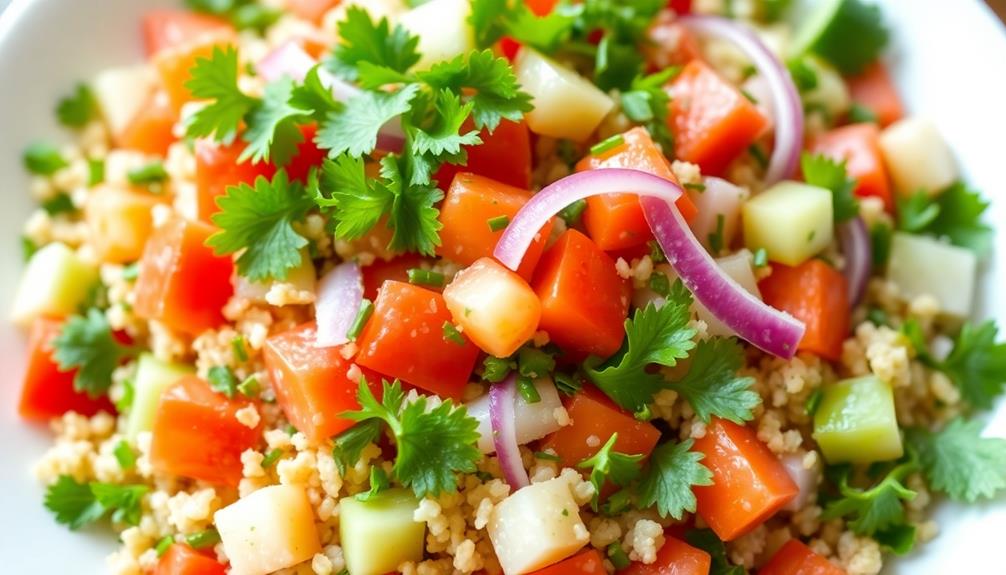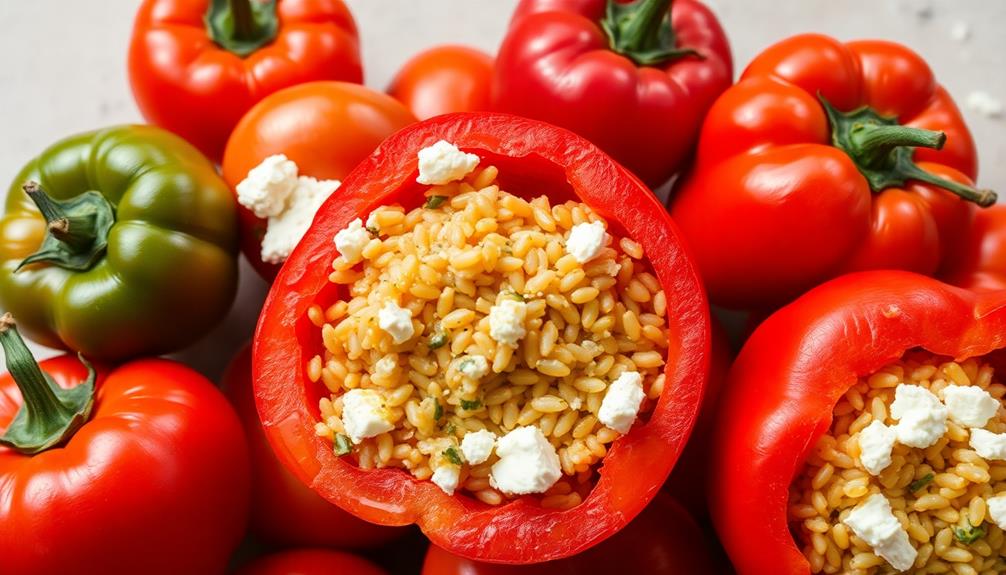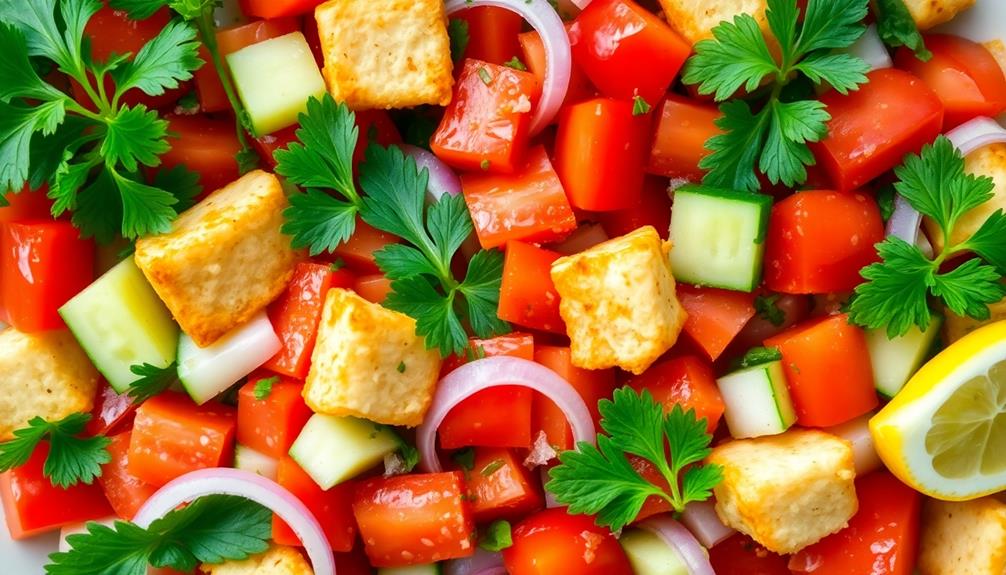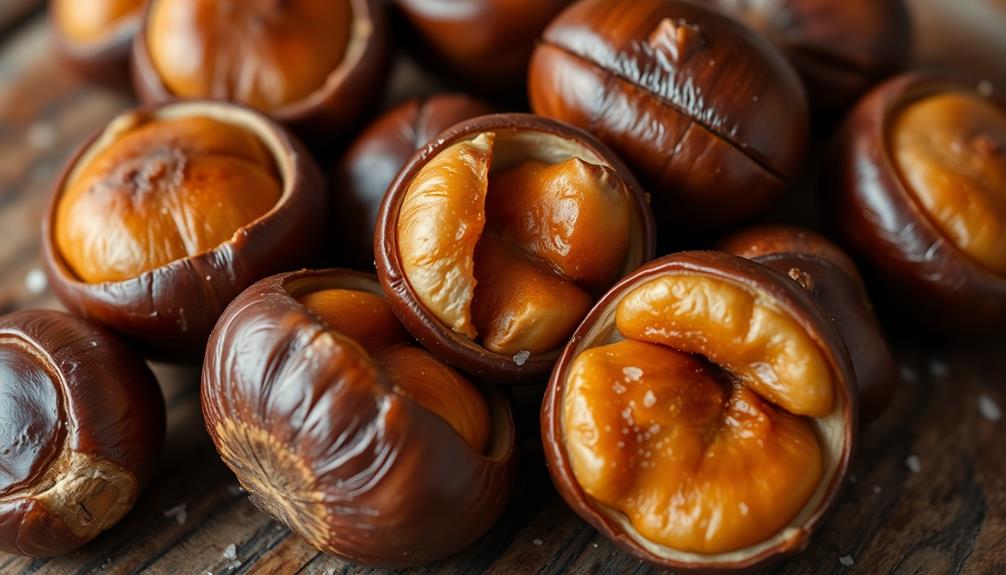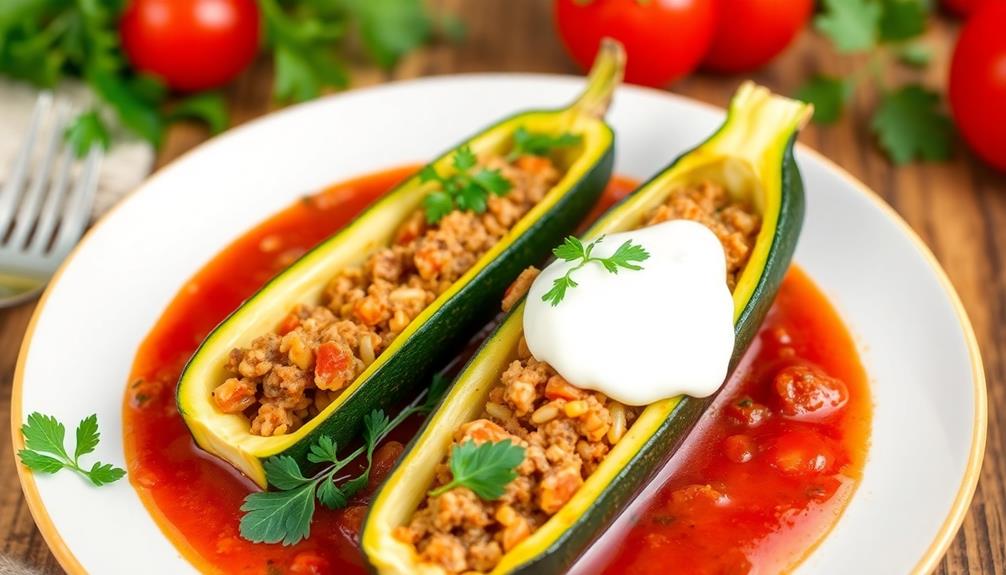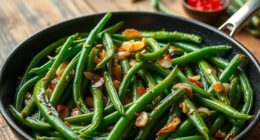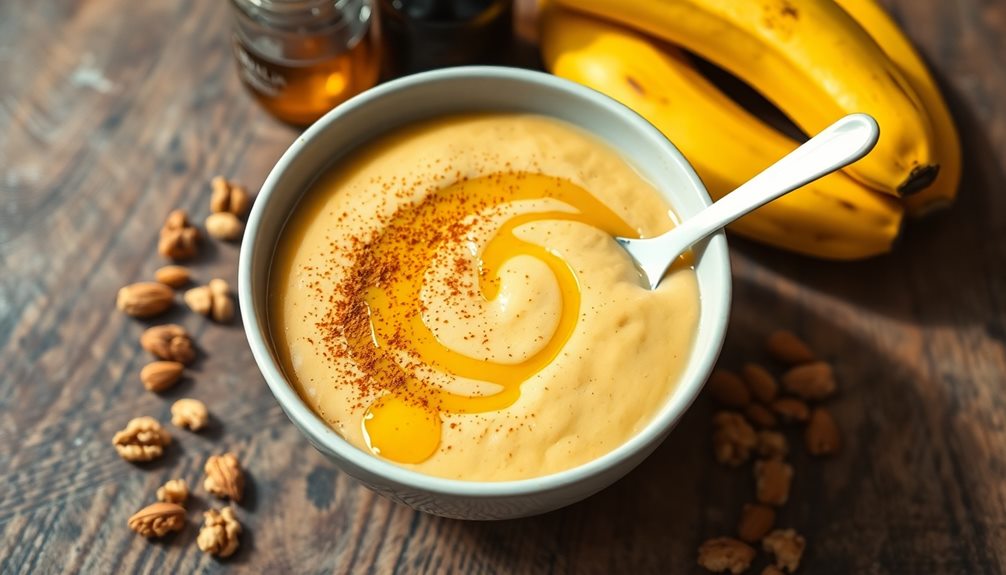Tabbouleh is a vibrant Middle Eastern salad that'll tantalize your taste buds. Originating in the Levant region, it's a staple from village tables to renowned restaurants. You'll start by thoroughly washing and chopping fresh parsley, mint, and tomatoes. Then, you'll soak bulgur wheat until softened, drain and squeeze it dry. Next, you'll combine the chopped veggies with the bulgur, bright lemon juice, and rich olive oil. After letting the flavors meld, you'll serve this healthy, flavorful salad garnished with mint. Tabbouleh showcases the vibrant tastes of Mediterranean cuisine – and there's more to discover.
Key Takeaways
- Tabbouleh is a popular Middle Eastern salad, originating in the Levant region, made with bulgur wheat, chopped parsley, mint, tomatoes, and flavored with lemon juice and olive oil.
- Traditional tabbouleh was a nourishing meal prepared by rural communities, but the dish has evolved over centuries and is now enjoyed globally.
- To prepare tabbouleh, the bulgur wheat is soaked in water, drained, and combined with the chopped fresh herbs, tomatoes, lemon juice, and olive oil.
- The salad is allowed to sit for 30 minutes to allow the flavors to blend, and it is typically served in bowls or on a platter, garnished with mint leaves.
- Tabbouleh is known for its vibrant flavors and versatility, with variations that may include different types of tomatoes, cucumbers, or even feta cheese.
History
Tabbouleh, a beloved Middle Eastern dish, has a rich and storied history that can be traced back to ancient times. This vibrant and refreshing salad, featuring a harmonious blend of fresh parsley, mint, bulgur wheat, tomatoes, and lemon juice, has been a staple in the cuisines of countries like Lebanon, Syria, and Palestine for centuries. Tabbouleh’s popularity has spread far beyond the Middle East, becoming a favorite in international cuisine and on menus around the world. Its light and tangy flavors make it a versatile side dish or main course. Additionally, its association with Middle Eastern cuisine pairs well with other beloved dishes from the region, like the history of shawarma, adding to its appeal for food enthusiasts.
The origins of tabbouleh can be found in the Levant region, where it was traditionally prepared by rural communities as a simple, nourishing meal. As the dish gained popularity, it evolved and spread throughout the Middle East, each region putting its own unique spin on the recipe.
Today, tabbouleh is enjoyed globally, showcasing the remarkable endurance and adaptability of this timeless culinary treasure. From humble village tables to renowned restaurants, tabbouleh continues to captivate the hearts and palates of food enthusiasts worldwide.
Cooking Steps
To prepare tabbouleh, begin by thoroughly washing the bulgur wheat, then drain and set it aside.
Next, chop the fresh parsley, mint, and tomatoes into small, uniform pieces. Be sure to remove any tough stems from the herbs.
In a large bowl, combine the chopped veggies with the bulgur. Drizzle in the olive oil, lemon juice, and a pinch of salt. Gently toss everything together until well mixed.
Taste and adjust the seasoning as needed, adding more lemon, oil, or salt to suit your preferences. For the best texture, let the tabbouleh sit for about 30 minutes before serving, allowing the flavors to meld.
When ready, spoon the refreshing salad into bowls or serve it on a platter. Garnish with a few extra mint leaves, if desired.
Enjoy this bright, herby tabbouleh as a light, healthy side dish or a satisfying meatless main course.
Step 1. Wash and Chop Parsley
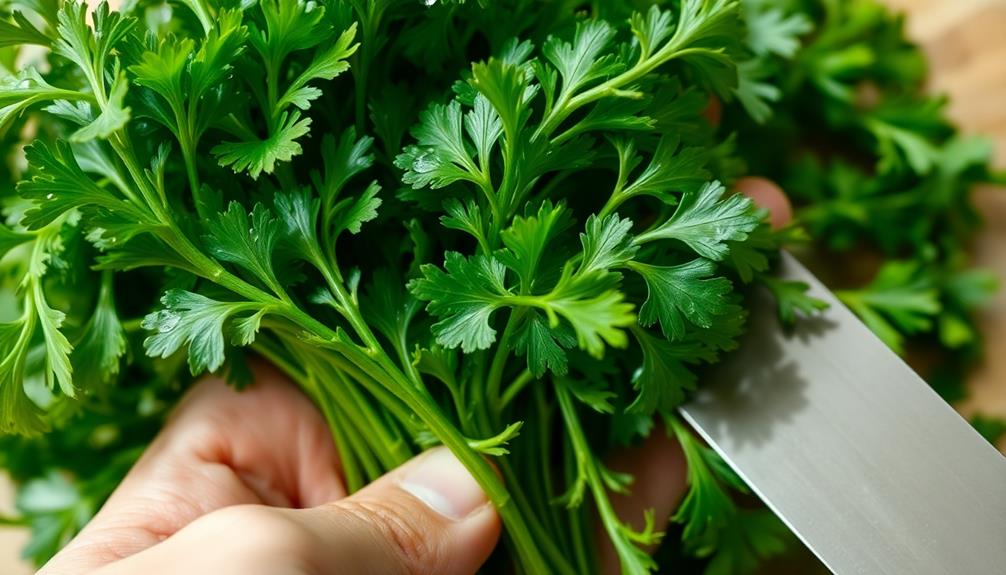
Before chopping the parsley, ensure to thoroughly wash it under cool running water. This helps remove any dirt, debris, or pesticides that may be on the leaves. Gently rub the parsley sprigs between your palms to dislodge any hidden grime. After rinsing, place the parsley on a clean kitchen towel or paper towels to pat dry.
Next, gather a sharp knife and a cutting board. Holding the parsley in a bunch, begin chopping it into small, fine pieces. Make sure to chop the leaves, stems, and tender parts of the plant. The smaller the pieces, the better they'll blend into the tabbouleh salad.
Continue cutting until you have a heaping pile of fragrant, green parsley. Be careful with your fingers, and take your time to ensure even, consistent chopping.
Once you've finished chopping, the parsley is ready to be added to the other tabbouleh ingredients. Its fresh, herbal flavor will be a delightful addition to the salad.
Step 2. Soak Bulgur in Water
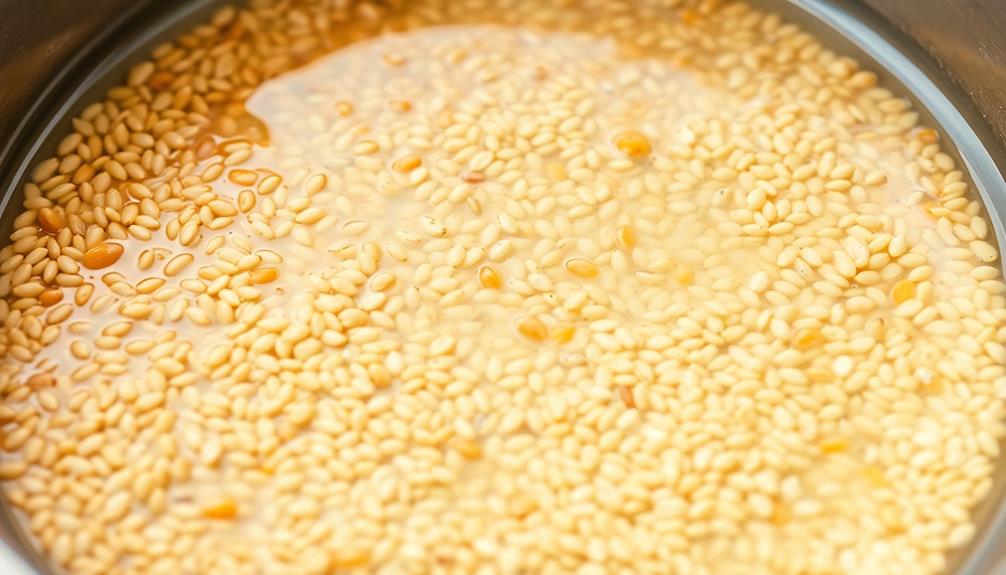
With the parsley prepped and ready, you can now turn your attention to the bulgur wheat, a key ingredient in tabbouleh. Bulgur is a type of cracked wheat that's been parboiled, dried, and then crushed. It's a versatile grain that adds a wonderful nutty flavor and chewy texture to this Middle Eastern salad.
To prepare the bulgur, simply place it in a medium bowl and cover it with water. Let it soak for about 30 minutes, or until the grains have softened and absorbed the liquid.
Drain the bulgur through a fine-mesh strainer, pressing gently to remove any excess water. At this point, the bulgur is ready to be combined with the chopped parsley, tomatoes, onions, and the other flavorful ingredients that make tabbouleh so delicious.
The soaked bulgur provides a great base for the fresh, vibrant flavors of the herbs and vegetables. You'll be amazed at how much this simple step of soaking the bulgur can enhance the overall texture and taste of your tabbouleh.
Step 3. Drain and Squeeze Bulgur Dry
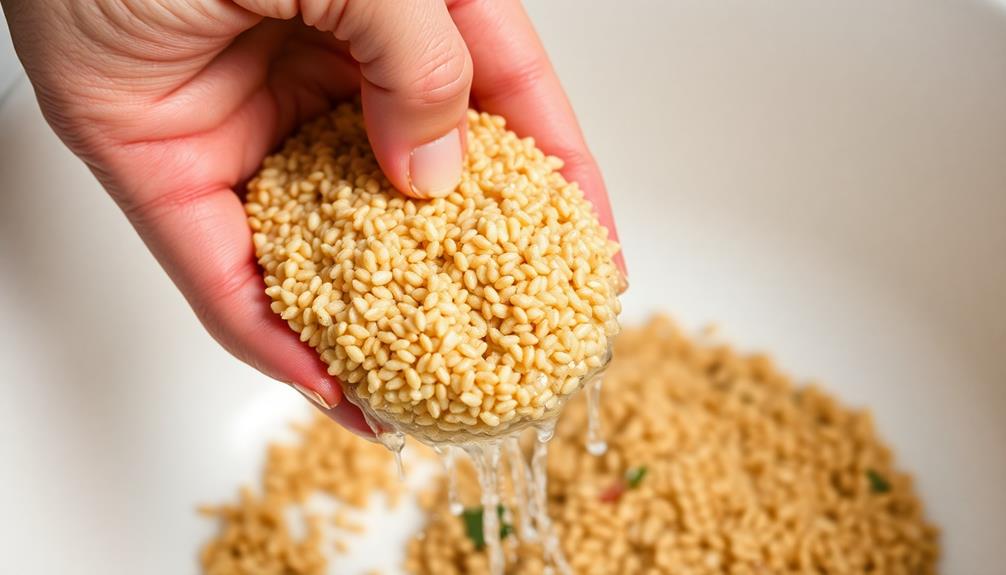
After the bulgur has soaked for about 30 minutes, drain it through a fine-mesh strainer.
You'll need to press down on the bulgur with the back of a spoon to help remove as much liquid as possible.
Once drained, transfer the bulgur to a clean kitchen towel or paper towels.
Gently squeeze and pat the bulgur to absorb any remaining moisture.
You want the bulgur to be nice and dry, so don't be afraid to really give it a good squeeze.
This step is crucial to ensure your tabbouleh salad has the perfect texture, with each grain of bulgur remaining light and fluffy.
Once the bulgur is thoroughly drained and dried, you're ready to move on to the next step of preparing your delicious tabbouleh.
Step 4. Add Chopped Tomatoes and Onions
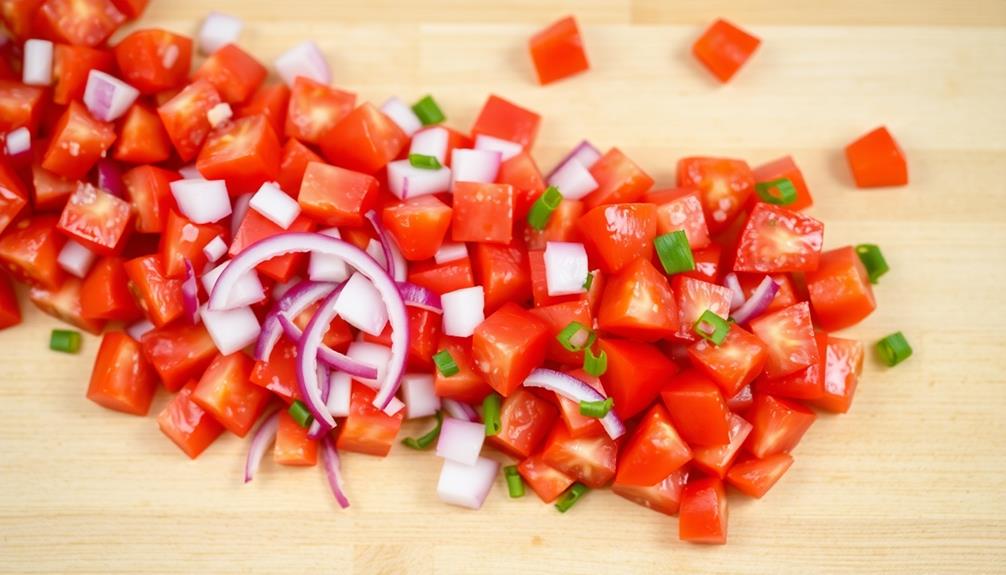
Next, chop the tomatoes and onions into small pieces. You'll want to make sure the tomato and onion chunks are about the same size as the bulgur you prepared earlier. This will help everything blend together nicely in the salad.
Dice the tomatoes and onions finely, aiming for pieces around 1/4 inch. The more evenly chopped, the better!
Once you've got your tomatoes and onions all ready to go, add them to the bowl with the bulgur. Use a large spoon to gently mix everything together.
The tomatoes and onions will add lots of fresh, vibrant flavors to the tabbouleh. Their crunchy texture also complements the soft, fluffy bulgur.
Keep mixing until all the ingredients are evenly distributed throughout the salad. Now you're one step closer to enjoying a delicious, authentic tabbouleh!
Step 5. Add Lemon Juice and Olive Oil
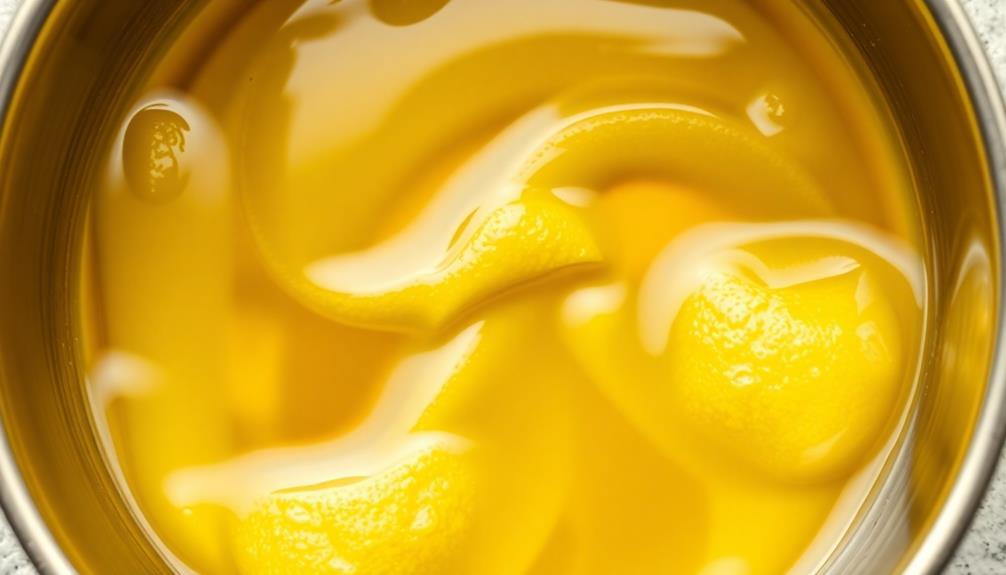
Once the bulgur, tomatoes, and onions are combined, it's time to add the lemon juice and olive oil. These two ingredients will really bring the tabbouleh to life!
First, squeeze a generous amount of fresh lemon juice over the salad. The tangy citrus will brighten up the flavors and balance the earthy bulgur.
Next, drizzle in a few tablespoons of high-quality olive oil. The rich, fruity oil will coat the ingredients and help everything meld together.
Make sure to toss the tabbouleh gently but thoroughly, so the lemon and oil get evenly distributed. You want each bite to have a perfect harmony of flavors.
The lemon will add a refreshing zing, while the olive oil will lend a smooth, velvety texture. Together, they'll transform the simple bulgur, tomatoes, and onions into an absolutely delicious Middle Eastern-inspired salad.
Keep tasting and adjusting the lemon and oil amounts until it tastes just right to you. With these final touches, your tabbouleh is ready to serve and enjoy!
Final Thoughts
Ultimately, tabbouleh is a vibrant, flavorful salad that showcases the best of Mediterranean cuisine.
It's the perfect balance of fresh herbs, tangy lemon, and rich olive oil that makes this dish so irresistible. Whether you're serving it as a side or the main event, tabbouleh is sure to impress your family and friends.
One of the best things about tabbouleh is its versatility. You can adjust the ratio of ingredients to suit your personal preferences, adding more or less of the herbs, bulgur, or vegetables.
And don't be afraid to get creative – try mixing in different types of tomatoes, cucumbers, or even some feta cheese for an extra burst of flavor.
No matter how you make it, tabbouleh is a healthy and delicious way to enjoy the fresh flavors of the Mediterranean.
Frequently Asked Questions
What Is the Best Ratio of Bulgur to Parsley in Tabbouleh?
When it comes to the perfect tabbouleh, the ratio of bulgur to parsley is key.
You'll want to use about 1 part bulgur to 3 parts fresh, chopped parsley. This creates a dish that's bursting with herby flavor, yet still has a nice, chewy texture from the bulgur.
Get the ratio right, and you'll be scooping up bite after bite of this refreshing Middle Eastern salad in no time!
Can Tabbouleh Be Made in Advance and Stored?
You sure can make tabbouleh ahead of time!
In fact, it's a great make-ahead dish. Just prepare the salad a day or two before you plan to serve it, and store it in the fridge.
The flavors will have time to meld, making your tabbouleh even more delicious.
When you're ready to enjoy it, give it a gentle stir and you're good to go. Easy peasy!
Is It Necessary to Use Fresh Lemon Juice in Tabbouleh?
Is Fresh Lemon Juice Necessary for Tabbouleh?
You bet fresh lemon juice is a must for tabbouleh! The bright, tangy flavor of real lemon really brings this tasty salad to life.
While you could use bottled lemon juice in a pinch, it just won't have the same zing and vibrancy as squeezing it fresh.
Plus, the juices will help soften the bulgur wheat and blend all the flavors together perfectly.
Can Tabbouleh Be Served as a Main Dish or Only as a Side?
Absolutely! Tabbouleh can absolutely be served as a main dish.
It's a wonderfully versatile salad that's packed with fresh, vibrant flavors. The combination of crisp vegetables, fragrant herbs, and tangy dressing makes it a satisfying meal on its own.
You can enjoy it as a light and healthy main course, or serve it alongside other dishes for a more substantial meal.
The choice is yours – tabbouleh is delicious either way!
Is Tabbouleh Typically Made With or Without Tomatoes?
Typically, tabbouleh is made with tomatoes! The juicy, sweet tomatoes add a delightful pop of color and flavor to this fresh and vibrant salad.
While some folks might leave them out, most recipes call for ripe, juicy tomatoes to be diced up and mixed right in. The tomatoes complement the other tasty ingredients like parsley, bulgur, and lemon juice perfectly.
